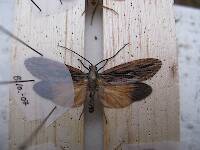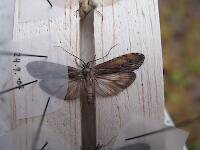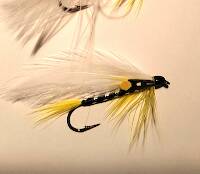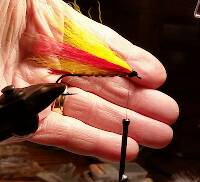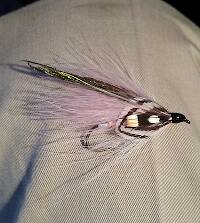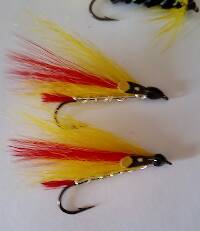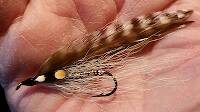
Salmonflies
Pteronarcys californica
The giant Salmonflies of the Western mountains are legendary for their proclivity to elicit consistent dry-fly action and ferocious strikes.
Featured on the forum

I caught this tiny larva without a case, but it seems to key pretty clearly to to Glossosomatidae. From there, the lack of sclerites on the mesonotum points to either Glossosoma or Anagapetus. Although it's difficult to see in a 2D image from the microscope, it's pretty clear in the live 3D view that the pronotum is only excised about 1/3 of its length to accommodate the forecoxa, not 2/3, which points to Glossosoma at Couplet 5 of the Key to Genera of Glossosomatidae Larvae.

Troutnut is a project started in 2003 by salmonid ecologist Jason "Troutnut" Neuswanger to help anglers and
fly tyers unabashedly embrace the entomological side of the sport. Learn more about Troutnut or
support the project for an enhanced experience here.

Dkuhn
Posts: 2
Posts: 2
Dkuhn on Sep 24, 2008September 24th, 2008, 12:57 pm EDT
Could anyone help with the identification of this insect as to genus and hopefully species. Common name would be great too.
Dwight
Dwight
Taxon on Sep 24, 2008September 24th, 2008, 2:05 pm EDT
Dwight-
I believe your caddisfly to be of genus Phryganea, probably P. sayi, but you also have P. cinerea in Maine. In either case, the common name would be Rush Sedge.
I believe your caddisfly to be of genus Phryganea, probably P. sayi, but you also have P. cinerea in Maine. In either case, the common name would be Rush Sedge.
Dkuhn
Posts: 2
Posts: 2
Dkuhn on Sep 25, 2008September 25th, 2008, 2:30 am EDT
Thanks for the information Roger.
D
D
Litobrancha on Sep 25, 2008September 25th, 2008, 2:58 pm EDT
Sure does look like a phryganea or agrypnia but I wonder about the scalloped wings... i've not seen them but there are some limnephilids up y'alls way that have this character. good looking bug.
is hesperophylax around those parts?
is hesperophylax around those parts?
Taxon on Sep 25, 2008September 25th, 2008, 10:53 pm EDT
Litobrancha-
The Limnephilid with the scalloped wings is Nemotaulius hostilis. However, their wing scalloping is much more exaggerated, and their wing patterning is quite different from Dwight's caddisfly.
Gonzo-
Am a bit surprised that you haven't weighed in on this one. Do you think I'm wrong in my belief that Dwight's caddisfly is Phryganea?
The Limnephilid with the scalloped wings is Nemotaulius hostilis. However, their wing scalloping is much more exaggerated, and their wing patterning is quite different from Dwight's caddisfly.
Gonzo-
Am a bit surprised that you haven't weighed in on this one. Do you think I'm wrong in my belief that Dwight's caddisfly is Phryganea?
GONZO on Sep 26, 2008September 26th, 2008, 4:25 am EDT
Roger,
For what it's worth (probably not much), I would also guess that this is Phryganea. That said, I certainly defer to Lito's knowledge of caddisflies and would like to learn more about his reservations. Agrypnia can be very similar, but the species listed for ME don't seem likely to me. I would be very surprised if this is Hesperophylax, but when limnephilids enter into the conversation, my eyes glaze over and my brain cramps. :)
For what it's worth (probably not much), I would also guess that this is Phryganea. That said, I certainly defer to Lito's knowledge of caddisflies and would like to learn more about his reservations. Agrypnia can be very similar, but the species listed for ME don't seem likely to me. I would be very surprised if this is Hesperophylax, but when limnephilids enter into the conversation, my eyes glaze over and my brain cramps. :)
Creno on Sep 26, 2008September 26th, 2008, 4:29 pm EDT
folks - it has been awhile since I looked at this forum. I would agree this is Phryganea, and perhaps sayi, although it would take a look at the private parts to be really sure. If you have a view of the apex of the hind wing it may help as most P.sayi have a darkened wing apex. Wiggins' phyganeid monograph provides photos of several Phryganea and the wings look pretty similar.
given the thread above I don't see the indication that this critter came from Maine. What did I miss?
While my stuff is all in ETOH where color patterns are usually reduced/lost, the wings of Agrypnia are usually more mottled and I think they all lack the black slashes/stripes in the forewings. In addition to Nemotaulius, some of the western Neophylax have the scalloped forewing apex. And Hesperophylax has a very distinct silver forewing strip.
creno
given the thread above I don't see the indication that this critter came from Maine. What did I miss?
While my stuff is all in ETOH where color patterns are usually reduced/lost, the wings of Agrypnia are usually more mottled and I think they all lack the black slashes/stripes in the forewings. In addition to Nemotaulius, some of the western Neophylax have the scalloped forewing apex. And Hesperophylax has a very distinct silver forewing strip.
creno
Taxon on Sep 26, 2008September 26th, 2008, 6:06 pm EDT
Creno-
There was no indication in the thread that either the critter or its photographer was from Maine. So, I googled Dwight Kuhn photography, discovered Dwight resides in Dexter, Maine, and made an assumption that he had probably taken the photo in-state. When offering an id opinion based on a single photo and little other information, it is generally necessary to employ to some rather extreme strategies, which rarely involve use of dichotomous keys.
given the thread above I don't see the indication that this critter came from Maine. What did I miss?
There was no indication in the thread that either the critter or its photographer was from Maine. So, I googled Dwight Kuhn photography, discovered Dwight resides in Dexter, Maine, and made an assumption that he had probably taken the photo in-state. When offering an id opinion based on a single photo and little other information, it is generally necessary to employ to some rather extreme strategies, which rarely involve use of dichotomous keys.
GONZO on Sep 30, 2008September 30th, 2008, 7:05 pm EDT
Roger,
P. cinerea seems to be far more widely distributed and collected in Maine than P. sayi. What was your reason for suggesting sayi as the probable species?
P. cinerea seems to be far more widely distributed and collected in Maine than P. sayi. What was your reason for suggesting sayi as the probable species?
Taxon on Oct 1, 2008October 1st, 2008, 4:30 am EDT
Hi Lloyd-
As I recall, it was the several weeks later emergence of P. sayi, which make it somewhat more likely to still be around.
As I recall, it was the several weeks later emergence of P. sayi, which make it somewhat more likely to still be around.
Creno on Oct 1, 2008October 1st, 2008, 7:58 am EDT
Photo submitted in September means it was taken is September? I guess that is another one of those assumptions taken to place a species name on a photo.
Taxon's comment on not using keys reminds me of a very old quote I saw someplace that I expect is still quite appropriate. Goes something like this....
Keys are made by folks who don't need them for folks who cannot understand them.
Having tried to make several fairly complex keys over the years, I totally understand the utter frustration of trying to simply state a truly complex distinction. The last couplets are the easiest and they get much tougher as you go toward the front of the key. Until the NA authors convert to the tabular approach they are a necessary evil for the inexperienced. But, they will always remain a treasure trove of valuable information for the experienced.
creno
Taxon's comment on not using keys reminds me of a very old quote I saw someplace that I expect is still quite appropriate. Goes something like this....
Keys are made by folks who don't need them for folks who cannot understand them.
Having tried to make several fairly complex keys over the years, I totally understand the utter frustration of trying to simply state a truly complex distinction. The last couplets are the easiest and they get much tougher as you go toward the front of the key. Until the NA authors convert to the tabular approach they are a necessary evil for the inexperienced. But, they will always remain a treasure trove of valuable information for the experienced.
creno
Quick Reply
Related Discussions
Topic
Replies
Last Reply
6
Jan 12, 2012
by Jmd123
by Jmd123



